
This document was originally a pamphlet that accompanied
classes I taught in the East Kingdom of the Society for Creative Anachronism, Inc.
Some changes have been made, mostly in order to refer to
other webbed documents or graphics.
This document is provided as is without any express or implied
warranties. While every effort has been taken to ensure the
accuracy of the information contained, the author assumes no
responsibility for errors or omissions, or for damages resulting
from the use of the information contained herein.
Permission is granted to make and distribute verbatim copies of this document for
non-commercial private research purposes provided the copyright notice and this permission
notice are preserved on all copies. Website mirroring is permitted by express prior arrangement.
Permission will only be granted if the document is posted in its entirety and the content and
format of the document remain completely unaltered by the mirroring site. The definitive
version of this document resides at www.cs.vassar.edu/~capriest/viktunic.html.
Viking Tunic Construction
Copyright © 1993, 1997 Carolyn Priest-Dorman.
Construction Choices
The main choices one makes when constructing a Viking tunic
are these: what fabric should I choose? How should I pre-treat
the fabric? How should I cut out the pieces? What do I want the
neck to look like? What kind of seams should I use? How should
I trim it? With which other garments should I wear it?
Generally speaking, a new tunic will satisfy the maker more if
all these questions have been answered before the tunic is cut.
This pamphlet will not discuss fabric pre-treatment; this is a
question that any competent garment-maker, modern or SCA, can
answer easily. Nor does it discuss the basics of tunic
construction or pattern drafting; this too any competent garment-
maker can provide. The questions of fabrics, trimmings, and
garment layering are touched on briefly: some suggestions for
appropriate textile and color choices are included, and some
information is included on decorative techniques that will help
you create ensembles based on a particular time and/or place.
However, the specific focus of this pamphlet is to help you make
the choices of cutting, neck shape, and seams that will make your
tunics specifically Viking in design.
Viking Garment Terminology
The word "tunic" really does not adequately describe the
number of different shirt- and coat-type garments worn in the
Viking Age (eighth through eleventh centuries, roughly speaking).
Accordingly, this work will use a variety of names for the body
garment. "Smock" refers to an undergarment, the thing we in the
Society might call a shirt if a man wore it and a chemise if a
woman wore it. "Tunic" is a man's short-skirted sleeved garment,
much as we already understand it. "Gown" is a woman's long-
skirted sleeved garment. "Jacket" is any man's sleeved
wraparound overcoat with overlapping lapels, and "coat" is any
man's or woman's sleeved overcoat that is buttoned or pinned
closed.
Tunic Garments in the Viking World
The recommendations made in this pamphlet are based on actual
clothing and clothing fragments together with the conjectural
reconstructions devised by archaeologists, textile experts, and
costume historians. Such information has come to light in the
following places: Thorsbjerg (Scheleswig-Holstein, Germany),
Migration Era; Evebø (Norway), fifth century; Birka
(Sweden), ninth and tenth centuries; Bjerringhøj
("Mammen," Denmark), tenth century; Hedeby (Schleswig-Holstein,
Germany), tenth and eleventh centuries; Jorvík (the
Danelaw in England) and Dublin (Ireland), tenth and eleventh
centuries; and Viborg (Denmark), eleventh century.
However, there is much more information out there than is
suggested by this short list of sources; it just isn't germane to
this particular pamphlet. See the bibliography for several
jumping-off places, not all of which are written in English.
Some translations from works in German by Inga Hägg have
been made accessible to me through the generosity of Mistress
Marieke van de Dal, sine qua non, ne plus ultra, whom I
thank profusely.
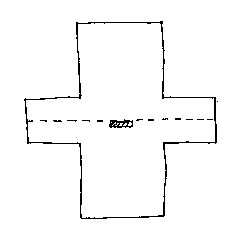 The
Mediterranean-style "cross" tunic, woven or cut in one piece
seems not to have been a northern European design. One author
(Hald 1980, 338) suggests that the colder northern climate
requires that clothing fit more closely than in the sunny south.
Certainly, the evidence from as far back as the Bronze Age is
that northern Europeans were fashioning garments cut and sewn in
several pieces for a close fit rather than the loose blousy fit
of a cross tunic.
The
Mediterranean-style "cross" tunic, woven or cut in one piece
seems not to have been a northern European design. One author
(Hald 1980, 338) suggests that the colder northern climate
requires that clothing fit more closely than in the sunny south.
Certainly, the evidence from as far back as the Bronze Age is
that northern Europeans were fashioning garments cut and sewn in
several pieces for a close fit rather than the loose blousy fit
of a cross tunic.
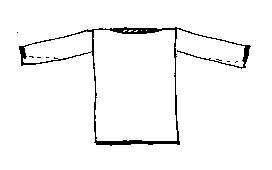 The
Thorsbjerg tunic is a well-preserved tunic found in a bog in
Schleswig-Holstein, Germany, in an area that was part of Denmark
during the Viking Age. It dates to the period just before the
Viking Age, and for the purpose of this pamphlet it is regarded
as a suitable early example of pre-Viking tunic construction. It
was made in four pieces: separate rectangular front and back
panels sewn together at the shoulders plus two sleeves. The
neckline was made by simply not sewing the middle section of the
two panels together, giving the effect of a boat neck. A pucker
was put at the back of each sleeve, 7cm below the shoulder seam,
to give a slightly more fitted effect at the sleeve-to-body seam.
Each sleeve was tapered toward the wrist not by cutting the
sleeves with a taper but by folding and seaming the lower half of
the sleeve more narrowly than the upper half. The sleeves were
overly long with narrow wrist openings; the visual effect of
wearing such a sleeve might be like the one so frequently
encountered in manuscript illuminations of the period--small
folds encircling the arm just above a tightly-fitting wrist.
According to the measurements given in Hald (1980, 339), the
tunic would come to about mid-thigh on someone 5'7" tall, and the
boat neckline would extend out to approximately the collarbones
on each side of the neck. The wrists and the bottom of the tunic
were trimmed with tablet-weaving. Although it isn't specifically
mentioned in either Hald, who describes the tunic in detail, or
in Owen-Crocker, who cites only Hald in the text but also
includes both a plate and a drawing of the piece, there may also
be tablet-weaving around the neckline.
The
Thorsbjerg tunic is a well-preserved tunic found in a bog in
Schleswig-Holstein, Germany, in an area that was part of Denmark
during the Viking Age. It dates to the period just before the
Viking Age, and for the purpose of this pamphlet it is regarded
as a suitable early example of pre-Viking tunic construction. It
was made in four pieces: separate rectangular front and back
panels sewn together at the shoulders plus two sleeves. The
neckline was made by simply not sewing the middle section of the
two panels together, giving the effect of a boat neck. A pucker
was put at the back of each sleeve, 7cm below the shoulder seam,
to give a slightly more fitted effect at the sleeve-to-body seam.
Each sleeve was tapered toward the wrist not by cutting the
sleeves with a taper but by folding and seaming the lower half of
the sleeve more narrowly than the upper half. The sleeves were
overly long with narrow wrist openings; the visual effect of
wearing such a sleeve might be like the one so frequently
encountered in manuscript illuminations of the period--small
folds encircling the arm just above a tightly-fitting wrist.
According to the measurements given in Hald (1980, 339), the
tunic would come to about mid-thigh on someone 5'7" tall, and the
boat neckline would extend out to approximately the collarbones
on each side of the neck. The wrists and the bottom of the tunic
were trimmed with tablet-weaving. Although it isn't specifically
mentioned in either Hald, who describes the tunic in detail, or
in Owen-Crocker, who cites only Hald in the text but also
includes both a plate and a drawing of the piece, there may also
be tablet-weaving around the neckline.
The garments of the fifth-century jarl buried at Evebø,
Norway, are too fragmentary to determine the way they were made.
The remains are mainly useful for what they reveal about tunic
length, decoration, and layering. The two wool garments were
found in situ with one worn over the other. The red undertunic
had elaborate tablet-woven wool trim at the neck, wrists, and
hem, with bronze wrist clasps; it came down as far as the knee.
The overtunic had a different type of tablet-woven wool trim at
the neck, plus silver clasps in some undetermined location
(Magnus 1982, 68-69). Given the existence of the silver clasps,
as well as the striking appearance of the undertunic, the
overgarment may well have been some sort of a coat designed to
augment, rather than cover, the undertunic; the clasps might have
held it together on the chest.
The excavations at Birka, Sweden, which cover the ninth and
tenth centuries, did not include entire garments. However, the
pieces of clothing that were found there yielded quite a bit of
information on different types of tunic-type garments, including
smocks, tunics, and coats. There is plenty of evidence for linen
smocks, wool tunics, wool and linen coats, and even one possibly
Byzantine-style linen long tunic. Construction details common to
them all include front and back panels cut in one piece, rather
than two-piece construction with shoulder seams, and small round
or keyhole necklines. Triangular gores were added for additional
width in the skirt area of many garments. Unique to Birka is
evidence for the woman's pleated smock from the tenth century;
this style of undergarment would not have required gores for
widening. Also unique to Birka is the men's sleeved "riding"
coat closed on the chest with small cast bronze buttons running
from neck to waist; it is thought to be influenced by Persian
riding coats by way of Byzantium and the Rus lands. Some Birka
women wore a similar overgarment, but instead of bronze buttons
this coat was held together by a fancy brooch pinned through two
small loops that were sewn to the two sides of the garment at the
mid-chest. It is not known how long the women's coats were, but
clearly if they were meant to be protective overgarments they
would need to be rather long--and require more than one closure
point in front!
Here below are suggested composite styles for a Birka tunic
and coat. Note especially the dotted fold lines at the shoulders
of both garments and the choice of two necklines offered on the
drawing of the tunic garment.
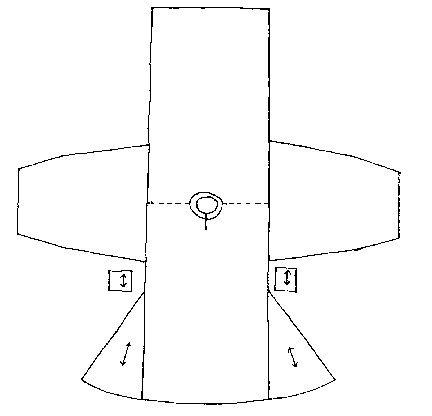
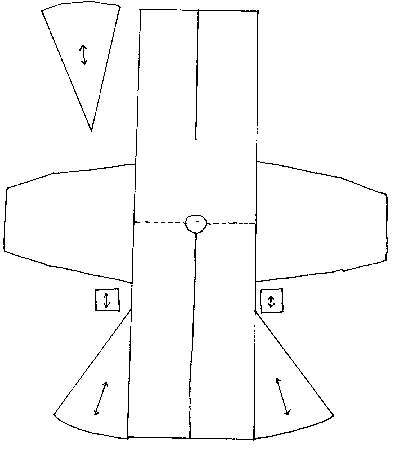
The tenth-century finds from Hedeby harbor offer sharp
contrast to the Birka style. Here are found wool garment pieces
that display rounded armholes for fitted sleeves, two-piece body
construction with shoulder seams, and scoop-style necklines (Hagg
1984, 171). Evidence for torso styles includes both a narrow
style with skirt slit at the sides, suitable for undergarments,
and a wider style with closed skirt and gores for more flair,
suitable for overgarments.
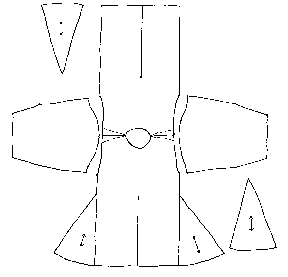 Here is a
suggested composite Hedeby-style tunic.
Here is a
suggested composite Hedeby-style tunic.
Also found at Hedeby is late tenth- or early eleventh-century
evidence for a short bathrobe-style jacket with overlapping front
panels. Similar garments are known from earlier Saxon graves on
the Continent and believed by some to have had some military or
ritual significance (Owen-Crocker 1986, 114-115); they are also
depicted in Migration Era artwork such as the Sutton Hoo helmet
plates. The remains of one jacket from Hedeby had a trimming
made of madder-dyed fake fur, which was a strip of woven wool
with tufts of unspun wool inserted into the weave.
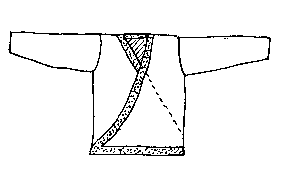 Here is
one possible reconstruction of such a jacket with its trimming of
fake fur.
Here is
one possible reconstruction of such a jacket with its trimming of
fake fur.
At Jorvík (York, England) several early eleventh-
century pieces came to light that are thought to have belonged to
a young child's linen smock. They comprise two sleeves, a side,
and part of an underarm gusset assembly (Walton 1989, 348).
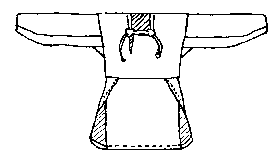 The last of
the Viking Age garments to be listed here is the Viborg linen
smock dating to the eleventh century that was found at Viborg
Søndersø, Denmark. Although many of the pieces had
come apart, much of the shirt was recovered. This smock has the
split sides of a type of Viking Age garment defined by Hägg
(1984, 177) as an undergarment; it is also unusual for having a
clear waist seam on both front and back panels. The rear
shirttail flap on this garment wraps around the front flap
slightly, just below the waist. The sleeves are cut in two
pieces each and also include square underarm gussets. The
illustration is of the reconstructed smock, which is most
remarkable for having the first clearly identifiable cinch-style
neckline (and square neckhole) of any Viking Age garment. (In
fact, I don't know of another extant garment or piece of garment
with this type of neckline, let alone a square neckhole, in any
early period northern European context!) The original shirt was
two layers thick; the front and back chest panels were "quilted"
together with running stitches.
The last of
the Viking Age garments to be listed here is the Viborg linen
smock dating to the eleventh century that was found at Viborg
Søndersø, Denmark. Although many of the pieces had
come apart, much of the shirt was recovered. This smock has the
split sides of a type of Viking Age garment defined by Hägg
(1984, 177) as an undergarment; it is also unusual for having a
clear waist seam on both front and back panels. The rear
shirttail flap on this garment wraps around the front flap
slightly, just below the waist. The sleeves are cut in two
pieces each and also include square underarm gussets. The
illustration is of the reconstructed smock, which is most
remarkable for having the first clearly identifiable cinch-style
neckline (and square neckhole) of any Viking Age garment. (In
fact, I don't know of another extant garment or piece of garment
with this type of neckline, let alone a square neckhole, in any
early period northern European context!) The original shirt was
two layers thick; the front and back chest panels were "quilted"
together with running stitches.
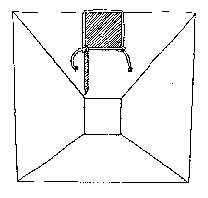 The
detail illustrated here shows both the pattern of the "quilting"
and the functioning of the neckline. There is a slit on the
outer layer of the garment, at the right side of the wearer's
neckline where the two layers of the garment overlap; the
functioning of the drawstring depends on this overlapping
section. The square neckhole was cut all on the front panel and
edged with a raised strip which becomes a sliding drawstring at
the front corners of the neckhole.
The
detail illustrated here shows both the pattern of the "quilting"
and the functioning of the neckline. There is a slit on the
outer layer of the garment, at the right side of the wearer's
neckline where the two layers of the garment overlap; the
functioning of the drawstring depends on this overlapping
section. The square neckhole was cut all on the front panel and
edged with a raised strip which becomes a sliding drawstring at
the front corners of the neckhole.
Textile Choices
Some garments, particularly undergarments, were made of linen,
hemp, or nettlecloth: many such smocks and the occasional coat
have been found. Although other forms of linen weaving were
known at the time, the archaeological evidence indicates that
almost all of these materials were in tabby weave. Linen, ramie-
cotton, or cotton-linen blends in tabby weave are easy to find
and make very appropriate choices for smocks, gowns, and
lightweight coats.
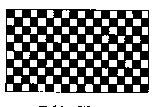 The
interlacement of a tabby weave looks like this.
The
interlacement of a tabby weave looks like this.
Wool gowns, tunics, jackets, coats, and lower-class smocks
(that is, body garments for people who couldn't afford linen)
were woven in 2/2 twill most commonly, although some examples
exist of broken chevron (herringbone) twill, broken lozenge
twill, plain broken twill (Kreuzkoper), repp, and tabby.
In the later Viking Age (tenth and eleventh centuries) 2/1 twills
became common. Also in the later Viking Age, some overgarments
were thick and fuzzy with less of a prominent twill texture. Of
these weaves, 2/1 twills and herringbones are the easiest to
locate commercially.
 The
interlacement of a 2/2 twill looks like this.
The
interlacement of a 2/2 twill looks like this.
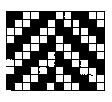 The
interlacement of a herringbone or broken chevron twill weave
looks like this.
The
interlacement of a herringbone or broken chevron twill weave
looks like this.
 The
interlacement of a broken lozenge twill looks like this.
The
interlacement of a broken lozenge twill looks like this.
The silk textiles used in the Viking Age were of roughly two
types: plain tabby-woven and samite, or silk twill. Plain
tabby-woven silk is fairly easy to come by; although "raw silk,"
or silk noil, is very unlike Viking Age silk tabbies in texture,
its thread count is quite appropriate. Silk gabardine makes a
good approximation of unpatterned samite, while rayon challis in
a suitable solid color makes a good substitute for plain samite;
it has the right kind of softness, sheen, and twill texture.
Unfortunately, good substitutes for patterned samite are wildly
expensive and/or rare.
No doubt a whole host of dyestuffs were used about which we
know nothing now; however, the following dyestuffs are known to
have been used on Viking Age textiles: reds from madder (and
kermes, on imported silks), yellows from broom (and weld, on
imported silks), blues from woad, purples from the lichen
Rocella tinctoris, browns from walnut husks, and even an
instance or two of black derived from walnut shells and iron
(Hägg 1984, 289). Overdyeing also achieved greens and a
large variety of violets and purples. Evidence for the use of
particular colors is strong in particular areas: reds are most
often found in the Danelaw, purples in Ireland, and blues and
greens in Scandinavia proper (Walton 1988, 18). Although it is
carefully hedged, there is a hypothesis in the scientific world
that this might possibly reflect regional color preferences
rather than archaeochemical factors; feel free to use this Viking
heraldry if you like the idea. Naturally pigmented wool was used
also, so off-whites, grays, blacks, and browns are all
appropriate. Some evidence for woad- and madder-dyed linens
exists, but most linens were undyed, which means that "natural"
through bleached white colors are also appropriate for
linens.
Selecting a Cutting Draft
There are various reasons to pick a particular cutting draft.
One might choose the draft that is most similar to tunics one has
made in the past; one might choose it for reasons of
authenticity, that is, one that is close in time and/or place to
the persona for whom it is being made; or one might choose the
style of tunic that one happens to know will look good on the
recipient. Hopefully, sufficient information is provided in this
section to make all three types of choices easier.
The following are the elements of a cutting draft which seem
to be common to most, if not all, Viking Age body garments:
- garment pieces are cut on the grain, that is, with warp
threads running vertically on the piece, rather than on the bias.
This is even true of underarm gussets and edging strips.
- where sleeves are preserved, they taper toward the wrist.
The following are the elements of a cutting draft for which
there are some choices represented in Viking Age tunics:
- neckline: keyhole (definitely known from ninth- and tenth-
century Sweden); rounded (definitely known from tenth- and
eleventh-century Denmark); or "boat" style (definitely known from
Migration Era Denmark). Keyhole necklines work well on
undergarments because they can be clasped close to the neck,
whereas rounded or boat necklines are less close-fitting and work
better on overgarments.
- side seams: slit, especially for men's smocks (definitely
known from tenth- and eleventh-century Denmark); straight
(definitely known from Migration Era Denmark); and straight with
triangular gores inserted (definitely known from ninth- and
tenth-century Sweden and tenth- and eleventh-century Denmark).
Women's smocks and gowns almost always require gores. Men's
riding coats require gores in order to achieve the fullness of
skirt that is needed to ride a horse while wearing the coat;
gores are optional on tunics and probably not needed on jackets.
Men's smocks can have slit sides for greater freedom of movement.
- sleeve/armhole: straight seam (definitely known from
Migration Era Denmark); straight or tapered seam with square
underarm gusset (definitely known from tenth-century Danelaw and
eleventh-century Denmark); and rounded armhole with rounded
sleeve (definitely known from tenth- and eleventh-century
Denmark). Individuals with large chest measurements proportional
to the rest of their anatomy--many women and fighters,
especially--will find that tunics with straight seams don't fit
as well because they don't provide any extra room across the
chest.
- shoulder construction: front and back panels cut with seams
(definitely known from Migration Era, tenth-, and eleventh-
century Denmark); front and back panels cut in one piece
(definitely known from ninth- and tenth-century Sweden).
Some Construction Tips
Decide how each element of the tunic should be constructed
before cutting out anything; then, if need be, make patterns out
of paper for each piece that you will need. If you do make paper
patterns, be careful to label each pattern piece with the name of
the intended wearer of the tunic, the name of the pattern piece
(e.g., "sleeve"), and the date. That way you will have a record
of how you made the tunic; then you can repeat it if the tunic
happens to come out perfect, or adjust the pattern pieces if the
tunic isn't perfect.
The front and back panels of a tunic work fairly well if they
are as wide as the measurement between the points of the
shoulders, plus seam allowances on both sides. Gores can be as
narrow or as wide as you like, but if they are too wide they will
hang in deep folds rather than draping gracefully.
It is almost impossible to reconstruct the sleeve length and
overall length of Viking garments from the pieces that remain.
Since sleeves were designed to be close-fitting at the lower end,
it is likely that they were wrist-length. Iconographic evidence
suggests that tunics were worn at least to mid-thigh, probably
down as far as the knee. Jackets seem to have been on the short
side, while Birka riding coats were probably longer than the
garments they were worn over, perhaps even calf-length. Women's
gowns might in some cases have extended only to the lower calf
or, as depicted in some figurines, drag behind with a miniature
train effect, depending on what sort of work may have needed to
be performed while wearing them. Ankle-length gowns and smocks
suit the climate and activity level of Pennsic very well, while
the train effect is very attractive in a Court setting.
Evidence for Viking garments frequently includes linings; in
particular, the coat garment was often lined with silk or linen.
Necklines were generally not faced, but enclosed by or edged with
durable or decorative trimmings. This effect can be achieved in
a variety of ways--by the use of bias tape, purchased trim,
braided wool yarn, tablet-weaving, or silk edgings cut out of
larger pieces of fabric.
Seam, Edge Treatments, and Trimmings
The main thing to remember when sewing a Viking tunic is that
the Vikings were much more relaxed about letting a seam show on
the outside of a garment than we are. Indeed, some seams were
even sewn in contrasting thread, quite possibly with the
intention of adding decorative flourishes to a garment. Seams
were also decorated in some cases with narrow braids or cords
(about 1mm wide): the braids were sewn down on the outside of
the garment over the line of the seam.
Seam treatments used in the Viking Age usually involve both a
running stitch and an overcast stitch. These seams include
several variations on the idea of flat-felling; a running stitch
holds the two pieces of fabric together, then the seam allowances
are folded in one of a variety of ways and tacked down with one
of a variety of overcast techniques. The seam frequently shows
on both sides of the fabric. Another interesting technique shows
up in late tenth-century Hedeby: the seam is sewn with a running
stitch on the inside of the garment, and the two raw edges are
folded in and overcast together, giving the effect of a French
seam. Hems came in a variety of styles, usually depending on the
weight of the fabric; lightweight silk hems were usually rolled;
linen, lightweight wool, and heavy silk ones were double-folded;
and heavy wool ones were single-folded. Sometimes hems were sewn
with contrasting color thread or in small groups of upright
stitches for decorative effect. For more information on seams,
hems, and seam finishing, see the drawings in Walton 1989 and
Hägg 1984.
Hand-sewn Viking garments are of course preferable, as
authenticity of technique usually is when it's not dangerous;
however, it's usually an unrealistic expectation that people will
hand-sew their garb. In such cases, practical adaptation of
these sewing techniques to a machine-sewn garment is fairly
simple. Flat-felled seams work well on smocks; the material for
such an undergarment is light enough that it is not difficult to
flat-fell a seam, and the machine stitching will not show if the
appropriate overgarment is worn. However, flat-felling is less
appropriate for outer layer garments such as tunics, coats,
jackets, pants, apron-dresses, and gowns; this is true not
because visible stitching is inappropriate to Viking garments but
because the kind of overstitching performed by a machine does not
look like the kind of overstitching performed by a Viking hand.
In such a case, French seams work very well and make the garment
much more durable than a less careful seam finish would.
Edge treatments show an interesting similarity across the
entire Viking world. If the edges are hemmed, then the hems are
most commonly left unadorned, although one or two decorated ones,
such as the tablet-woven hem on the tunic of the Evebø
jarl, have been found. But a large number of edges, especially
at wrists, jacket flaps, and necks, were ornamented by strips of
silk samite. Samite was a product of Byzantium, a thick, rich,
silk twill that was woven in patterns that were often elaborate
and multicolored. The strips cut from samite and used to
decorate Viking garments did not follow the directions of a
pattern; some surviving strips seem to have been cut by someone
with a healthy disdain for the weaver's intentions! Once cut
into strips, sometimes the silk was treated like bias tape (i.e.,
enclosing the raw edge of the garment material), and sometimes
the edges of the samite strip were folded under neatly and the
whole piece sewn down (i.e., like trim) on top of the garment
material. This is probably the single most common element in
Viking Age garment decoration.
Two definite examples of embroidery on the tunic garment have
been uncovered: the Oseberg women both had embroidery on their
upper gowns. Sable, marten, and squirrel fur was also used as a
trimming and possibly a lining on some of the Birka coats. Much
more common than embroidery or fur, however, was the use of
metal-brocaded tablet-woven bands;
they were applied directly to tunics, gowns, and coats, or sewn
to strips of samite that were then applied to the garments as
described above. These bands were usually a centimeter or less
in width and involved a single bright color brocaded with silver;
isolated examples of gold brocading, and of the use of more than
one color of background, also exist. A form of decoration unique
to Birka was the solid or spiral-wrapped silver wire that was
worked into knotwork, little figures, or mesh patterns; it too
was often sewn to samite before being used on men's coats and
their matching hats.
Some of the interesting trimmings from Birka have been
misinterpreted in several mainstream books on Vikings. One
particularly blatant instance of this is the horizontal overlay
from Birka Grave 735. Dating to the mid-tenth century, it
consisted of strips of silver brocaded tablet-weaving sewn
horizontally across a rectangle of samite, which was then sewn
down to the chest of a man's wool tunic (Geijer 1938, 165-6).
Additional strips of silk and tablet weaving ran up his arms
(Hägg 1986, 69) as well as around the arms of the tunic.
This is the find that has inspired the drawings of men in Rus
riding coats in many Viking picture books, including Almgren and
the cover of the Osprey Elite Series book on the Vikings. Those
drawings are wrong; no coat garment is known to have been
decorated in such a fashion. The man in the coat on the cover of
the Osprey Elite book is also wearing an artist's
misinterpretation of the Reverskragen, or lapel, which was
found in some of the other graves at Birka. The
Reverskragen probably belongs on a jacket, not a coat.
Follow this link for a portrait
of my husband wearing a Birka-style tunic with a reconstruction
of the chest portion of the Grave 735 trimming.
One tenth-century Birka overtunic was decorated with long
vertical strips of brocaded tablet-weaving from shoulders to
calves (Hägg 1986, 69), which must have looked somewhat like
Byzantine clavii. It was also trimmed with Chinese self-
patterned damask silk (Geijer 1983, 86); at the time the man was
buried, the silk would have been several hundred years old!
Garment Layering
As a very general rule of thumb, it is appropriate to layer
several garments together for warmth rather than depending on one
blanket-like outer tunic. Both men and women can wear smocks
made of linen or an affordable approximation. Men wear a tunic
over the smock, women a gown. Women wear an apron-dress over the
gown. Men can wear the jacket or a light cloak for a degree of
warmth. Men and women can both wear the coat garment for more
warmth.
For more information on garments and their ornamentation in
the Viking period, see also the documents on Þóra's Viking Resources
page.
Bibliography
Almgren, Bertil, ed. 1966. The Viking. Stockholm:
Tre Tryckare, Cagner & Co.
This book has much to recommend it, but its
reconstructions of men's garments are 25 years behind the times
and even misunderstand much of the material that was available
when the book was written! The man wearing the cruciform
headband and the little scarf with the stag on it is based on
misinterpretations of factual evidence from Birka. Don't make
the mistake of basing your garb on this fellow.
Dal, Marieke van de [Christina Krupp]. 1992. "New Sources for
Viking Men's Garb," Pikestaff Arts and Sciences
Supplement, pp. 21-23. Pittsburgh, Pennsylvania: Society
for Creative Anachronism, Inc., December 1992.
This article details some of the Hedeby and Birka
garments. It is illustrated with Viking paper
dolls.
Fentz, Mytte. "An 11th Century Linen Shirt from Viborg
Sondersø, Denmark," Archaeological Textiles in
Northern Europe, pp. 83-92, ed. Lise Bender
Jørgensen and Elisabeth Munksgaard. Tidens Tand 5.
Copenhagen: Kongelige Danske Kunstakademi, 1992.
An in-depth analysis and reconstruction of the most
complete surviving linen smock from the Viking Age.
Geijer, Agnes. 1938. Die Textilfunde aus den
Gräbern. Birka: Untersuchungen und Studien III.
Uppsala: Kungl. Vitterhets Historie och Antikvitets Akadamien,
1938.
This book is an early paradigm of archaeological
textile scholarship, but it's not available in translation.
Great plates of metal trimmings, and extensive lists of textile
finds broken down by grave.
Geijer, Agnes. 1983. "The Textile Finds from Birka," in
Cloth and Clothing in Medieval Europe, ed. N.B.
Harte and K.G. Ponting, pp. 80-99. London: Heinemann.
Good, digested, English version of Birka
III. Skims over all the types of garmet-related finds
from Birka. Great photo of some Viking macramé in
situ, some diagrams of the patterns on tablet-woven metallic
trims, and brief discussion of the unusual embroidered and
twisted wire trims.
Hägg, Inga. 1974. Kvinnodrakten i Birka:
Livplaggens Rekonstruktion pa Grundval av det Arkaeologiska
Materialet. Uppsala: Archaeological Institute.
An early survey of the Birka finds; short German
summary at the end. Her later works are much more useful,
though.
Hägg, Inga. 1983. "Viking Women's Dress at Birka: A
Reconstruction by Archaeological Methods.: Cloth and
Clothing in Medieval Europe, ed N.B. Harte and K.G.
Ponting, pp. 316-50. London: Heinemann.
A little heavy for non-archaeologists, but not
incomprehensible. Extremely valuable information on the order of
garment layering.
Hägg, Inga. 1984. Die Textilfunde aus dem Hafen von
Haithabu. Berichte über die Ausgrabungen in
Haithabu, Bericht 20. Neumünster: Karl Wachholz Verlag.
Write-ups on the garment pieces used as caulking that
were discovered in Hedeby harbor. Distinguished by careful
analysis of weaves, suggested reconstructions of cuts, and useful
information about sewing stitches and techniques. Lots of good
photos and diagrams for those who don't read German.
Hägg, Inga. 1986. "Die Tracht." Birka II:2,
Systematische Analysen der Graberfunde, ed. Greta
Arwidsson, pp. 51-72. Stockholm: Almquist & Wiksell.
A modern re-analysis of dress at Birka, building on
the work of Geijer but also incorporating microstratigraphic work
on some of the preserved lumps of textiles. Quite valuable:
confirms or refutes many of the major assumptions about clothing
in the period, and even offers fledgling theories of the
evolution of fashion.
Hald, Margrethe. 1980. Ancient Danish Textiles from Bogs
and Burials, trans. Jean Olsen. Copenhagen: National
Museum of Denmark.
In addition to write-ups on a huge variety of finds
of textiles from the Bronze Age through the medieval period, this
book contains a good diagram of the Thorsbjerg pants pattern.
Good drawings and a few very good photos.
Heath, Ian. 1985. The Vikings. Osprey Elite
Series 3. London: Osprey Publishing Ltd.
A good, concise book on Vikings from the military
standpoint, with several reasonable colour drawings. The most
undocumentable features of these plates are the cross-gartering--
a Frankish style--and the trimmings on the bottoms of tunics--
only found at pre-Viking sites like Evebø so far.
Although it's nice they included one, the drawing of women's
garments is pretty bad.
Ingstad, Anne Stine. 1982. "The Functional Textiles from the
Oseberg Ship." Textilsymposium Neumünster:
Archäologische Textilfunde, 6.5. - 8.5.1981., ed.
Lise Bender Jørgensen and Klaus Tidow, pp. 85-96.
Neumünster: Textilmuseum Neumünster.
Briefly discusses the garments of the queen and her
servant buried in the ship at Oseberg, circa 834. Tantalizing,
rare information.
Ingstad, Anne Stine. 1988. "Textiles from Oseberg, Gokstad and
Kaupang." Archaeological Textiles: Report from the Second
NESAT Symposium, 1-4 May 1984., ed. Lise Bender
Jørgensen, Bente Magnus, and Elisabeth Munksgaard, pp.
133-149. Arkaeologiske Skrifter 2. Købnhavn:
Arkaeologisk Institut, Købnhavns Universitet.
Bits and pieces of information from various Norwegian
sites, mainly for comparison purposes.
Krupp, Christina, and Priest-Dorman, Carolyn. 1992. "Women's
Garb in Northern Europe, 450-100 C.E.: Frisians, Angles, Franks,
Balts, Vikings, and Finns." Compleat Anachronist 59
(January 1992). Milpitas, California: The Society for Creative
Anachronism.
Some more in-depth discussion of Viking Age textiles,
trimmings, and women's garment layering is available in this
pamphlet.
Magnus, Bente. 1982. "A Chieftain's Costume: New Light on an
Old Grave Find from West Norway." Textilsymposium
Neumünster: Archäologische Textilfunde, 6.5 -
8.5.1981., ed. Lise Bender Jørgensen and Klaus
Tidow, pp. 63-73. Neumünster: Textilmuseum
Neumünster.
A catalogue of the six textiles from the Evebø
find, a man's burial from the fifth century containing, among
other things, plaid pants and cloak. Some garment information is
included.
Owen-Crocker, Gale R. 1986. Dress in Anglo-Saxon
England. Wolfeboro, NH: Manchester University Press.
Assembles linguistic, iconographic, and
archaeological information on men's and women's clothing in
England from the period of the Saxon invasion to the Norman
invasion. Not without its flaws, but the best one-book version
out there; good footnotes and bibliography. Recently issued in
paperback.
Pritchard, Frances. 1988. "Silk Braids and Textiles of the
Viking Age from Dublin," in Archaeological Textiles:
Report from the Second NESAT Symposium, 1-4 May 1984., ed.
Lise Bender Jørgensen, Bente Magnus, and Elisabeth
Munksgaard, pp. 149-61. Arkaeologiske Skrifter 2.
Købnhavn: Arkaeologisk Institut, Købnhavns
Universitet.
Roesdahl, Else, and Wilson, David M. 1992. From Viking to
Crusader. New York: Rizzoli International Publications
Ltd.
This is the catalogue of the 1992-1993 exhibition
that toured Europe, the largest exhibition of Viking Age
artifacts ever mounted. Some of the photos and exhibits are
being reported and published for the first time in this book. A
few of the the write-ups are not in line with current thinking,
and the two-page article on dress has many serious inaccuracies,
including the "reconstruction" of the Mammen outfit on page 193
that obscures such elementary information provided by the
original find as which embroideries were in proximity to others!
Still, on grounds other than that of garb documentation, it's
well worth the $65 it costs, and it's still available in some
places.
Walton, Penelope. 1988. "Dyes of the Viking Age: A Summary
of Recent Work," in Dyes in History and Archaeology
7, pp. 14-19.
Although kind of technical, the best few-page summary
out there. Contains information on spectrochemical analysis as
well as botanical information for various Viking Age
dyes.
Walton, Penelope. 1989. Textiles, Cordage and Fiber from
16-22 Coppergate. The Archaeology of York, Vol. 17: The
Small Finds, Fascicule 5. Dorchester: The Council for British
Archaeology and The Dorset Press.
Careful, detailed archaeological analysis of the
textiles found from the late ninth- through early eleventh-
century period of the Anglo-Scandinavian site of Jorvik. A linen
find thought to be a child's smock is discussed, in addition to
textile production generally and the specific fibers, weaves,
colors and construction stitches used there.
This page was created on 26 March 1997 and last updated on
17 April 1997.
Search this
site | Back to Þóra's
Viking Resources>
No soliciting! | capriest@cs.vassar.edu
 The
Mediterranean-style "cross" tunic, woven or cut in one piece
seems not to have been a northern European design. One author
(Hald 1980, 338) suggests that the colder northern climate
requires that clothing fit more closely than in the sunny south.
Certainly, the evidence from as far back as the Bronze Age is
that northern Europeans were fashioning garments cut and sewn in
several pieces for a close fit rather than the loose blousy fit
of a cross tunic.
The
Mediterranean-style "cross" tunic, woven or cut in one piece
seems not to have been a northern European design. One author
(Hald 1980, 338) suggests that the colder northern climate
requires that clothing fit more closely than in the sunny south.
Certainly, the evidence from as far back as the Bronze Age is
that northern Europeans were fashioning garments cut and sewn in
several pieces for a close fit rather than the loose blousy fit
of a cross tunic.
 The
Thorsbjerg tunic is a well-preserved tunic found in a bog in
Schleswig-Holstein, Germany, in an area that was part of Denmark
during the Viking Age. It dates to the period just before the
Viking Age, and for the purpose of this pamphlet it is regarded
as a suitable early example of pre-Viking tunic construction. It
was made in four pieces: separate rectangular front and back
panels sewn together at the shoulders plus two sleeves. The
neckline was made by simply not sewing the middle section of the
two panels together, giving the effect of a boat neck. A pucker
was put at the back of each sleeve, 7cm below the shoulder seam,
to give a slightly more fitted effect at the sleeve-to-body seam.
Each sleeve was tapered toward the wrist not by cutting the
sleeves with a taper but by folding and seaming the lower half of
the sleeve more narrowly than the upper half. The sleeves were
overly long with narrow wrist openings; the visual effect of
wearing such a sleeve might be like the one so frequently
encountered in manuscript illuminations of the period--small
folds encircling the arm just above a tightly-fitting wrist.
According to the measurements given in Hald (1980, 339), the
tunic would come to about mid-thigh on someone 5'7" tall, and the
boat neckline would extend out to approximately the collarbones
on each side of the neck. The wrists and the bottom of the tunic
were trimmed with tablet-weaving. Although it isn't specifically
mentioned in either Hald, who describes the tunic in detail, or
in Owen-Crocker, who cites only Hald in the text but also
includes both a plate and a drawing of the piece, there may also
be tablet-weaving around the neckline.
The
Thorsbjerg tunic is a well-preserved tunic found in a bog in
Schleswig-Holstein, Germany, in an area that was part of Denmark
during the Viking Age. It dates to the period just before the
Viking Age, and for the purpose of this pamphlet it is regarded
as a suitable early example of pre-Viking tunic construction. It
was made in four pieces: separate rectangular front and back
panels sewn together at the shoulders plus two sleeves. The
neckline was made by simply not sewing the middle section of the
two panels together, giving the effect of a boat neck. A pucker
was put at the back of each sleeve, 7cm below the shoulder seam,
to give a slightly more fitted effect at the sleeve-to-body seam.
Each sleeve was tapered toward the wrist not by cutting the
sleeves with a taper but by folding and seaming the lower half of
the sleeve more narrowly than the upper half. The sleeves were
overly long with narrow wrist openings; the visual effect of
wearing such a sleeve might be like the one so frequently
encountered in manuscript illuminations of the period--small
folds encircling the arm just above a tightly-fitting wrist.
According to the measurements given in Hald (1980, 339), the
tunic would come to about mid-thigh on someone 5'7" tall, and the
boat neckline would extend out to approximately the collarbones
on each side of the neck. The wrists and the bottom of the tunic
were trimmed with tablet-weaving. Although it isn't specifically
mentioned in either Hald, who describes the tunic in detail, or
in Owen-Crocker, who cites only Hald in the text but also
includes both a plate and a drawing of the piece, there may also
be tablet-weaving around the neckline.

 Here is a
suggested composite Hedeby-style tunic.
Here is a
suggested composite Hedeby-style tunic. Here is
one possible reconstruction of such a jacket with its trimming of
fake fur.
Here is
one possible reconstruction of such a jacket with its trimming of
fake fur. The last of
the Viking Age garments to be listed here is the Viborg linen
smock dating to the eleventh century that was found at Viborg
Søndersø, Denmark. Although many of the pieces had
come apart, much of the shirt was recovered. This smock has the
split sides of a type of Viking Age garment defined by Hägg
(1984, 177) as an undergarment; it is also unusual for having a
clear waist seam on both front and back panels. The rear
shirttail flap on this garment wraps around the front flap
slightly, just below the waist. The sleeves are cut in two
pieces each and also include square underarm gussets. The
illustration is of the reconstructed smock, which is most
remarkable for having the first clearly identifiable cinch-style
neckline (and square neckhole) of any Viking Age garment. (In
fact, I don't know of another extant garment or piece of garment
with this type of neckline, let alone a square neckhole, in any
early period northern European context!) The original shirt was
two layers thick; the front and back chest panels were "quilted"
together with running stitches.
The last of
the Viking Age garments to be listed here is the Viborg linen
smock dating to the eleventh century that was found at Viborg
Søndersø, Denmark. Although many of the pieces had
come apart, much of the shirt was recovered. This smock has the
split sides of a type of Viking Age garment defined by Hägg
(1984, 177) as an undergarment; it is also unusual for having a
clear waist seam on both front and back panels. The rear
shirttail flap on this garment wraps around the front flap
slightly, just below the waist. The sleeves are cut in two
pieces each and also include square underarm gussets. The
illustration is of the reconstructed smock, which is most
remarkable for having the first clearly identifiable cinch-style
neckline (and square neckhole) of any Viking Age garment. (In
fact, I don't know of another extant garment or piece of garment
with this type of neckline, let alone a square neckhole, in any
early period northern European context!) The original shirt was
two layers thick; the front and back chest panels were "quilted"
together with running stitches. The
detail illustrated here shows both the pattern of the "quilting"
and the functioning of the neckline. There is a slit on the
outer layer of the garment, at the right side of the wearer's
neckline where the two layers of the garment overlap; the
functioning of the drawstring depends on this overlapping
section. The square neckhole was cut all on the front panel and
edged with a raised strip which becomes a sliding drawstring at
the front corners of the neckhole.
The
detail illustrated here shows both the pattern of the "quilting"
and the functioning of the neckline. There is a slit on the
outer layer of the garment, at the right side of the wearer's
neckline where the two layers of the garment overlap; the
functioning of the drawstring depends on this overlapping
section. The square neckhole was cut all on the front panel and
edged with a raised strip which becomes a sliding drawstring at
the front corners of the neckhole. The
interlacement of a tabby weave looks like this.
The
interlacement of a tabby weave looks like this. The
interlacement of a 2/2 twill looks like this.
The
interlacement of a 2/2 twill looks like this. The
interlacement of a herringbone or broken chevron twill weave
looks like this.
The
interlacement of a herringbone or broken chevron twill weave
looks like this. The
interlacement of a broken lozenge twill looks like this.
The
interlacement of a broken lozenge twill looks like this.